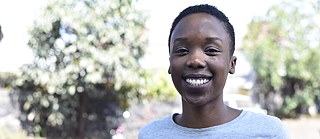Interview
Amelia Umuhire

„Tuko – Life in Goma“ – Five episodes follow the lives of young people from Rwanda and the Democratic Republic of Congo in the city of Goma. The episodes were developed within a workshop lead by the Rwandese director Amelia Umuhire who grew up in Germany. In this interview she speaks about her fear for the neighboring country, about the revolutionary idea of the web series – and about carrots.
What lead you to conduct a workshop in Goma for Rwandese and Congolese participants?
As a Rwandese and German it is important for me to get to know my neighbors apart from alleged cliché images or prejudices. Because of our history we as Rwandese as well as Congolese feel far more distances than we actually are. In our workshop both young people from Rwanda as well as from DR Congo come together. All of us have noticed that we previously had another perception of each other. Especially for us as the producers of images it is important to see how an image starts to take shape, and, how it refers to prejudices. The workshop was about creating a shared image of reality as it is real for us.
What are you taking home from your neighboring country, now that you have become acquainted with it?
The country, DR Congo, had been next to me all the time and yet it was not there for me. Just because of fear. But this fear was completely unjustified. This was a life-changing insight for me. I have realized that you should not let yourself be stopped by such preconceptions.
Is there a souvenir you intend to buy?
I will definitely take with me the Goma-t-shirts with their typical symbols or Lumbumba. And a small Tshukudu the characteristic load roller. And matches – here they have really great matches.
Are you ok with the local food?
I like the meat here, and the vegetables. They taste truly different, especially the carrots. And the fish is really tasty, too.
Five episodes of a web series have been developed in Goma. Why did you exactly choose this format?
Web series can tell stories, which usually would not be found on TV or in other media. There are no restrictions. The films can be seen by all people who have internet access. Likewise in Goma you find more and more smartphones. It gives people the opportunity to show their region from their own perspective, which might have been often seen in the media but always from a certain angle – a focus on poverty, suffering, violence. The repetition of this image leads to an internalization of this image for the inhabitants of this site, too. The web series however does not have any restrictions and there is no need for a lot of technical equipment – this has really something revolutionary about it.
What episodes are there?
The five episodes talk about the lives of children in Goma. They examine the similarities between bars and churches, which were lately often built door to door. They portray artists who raise taboo topics and deal with the love-hate relationship of Goma’s citizens with nature.